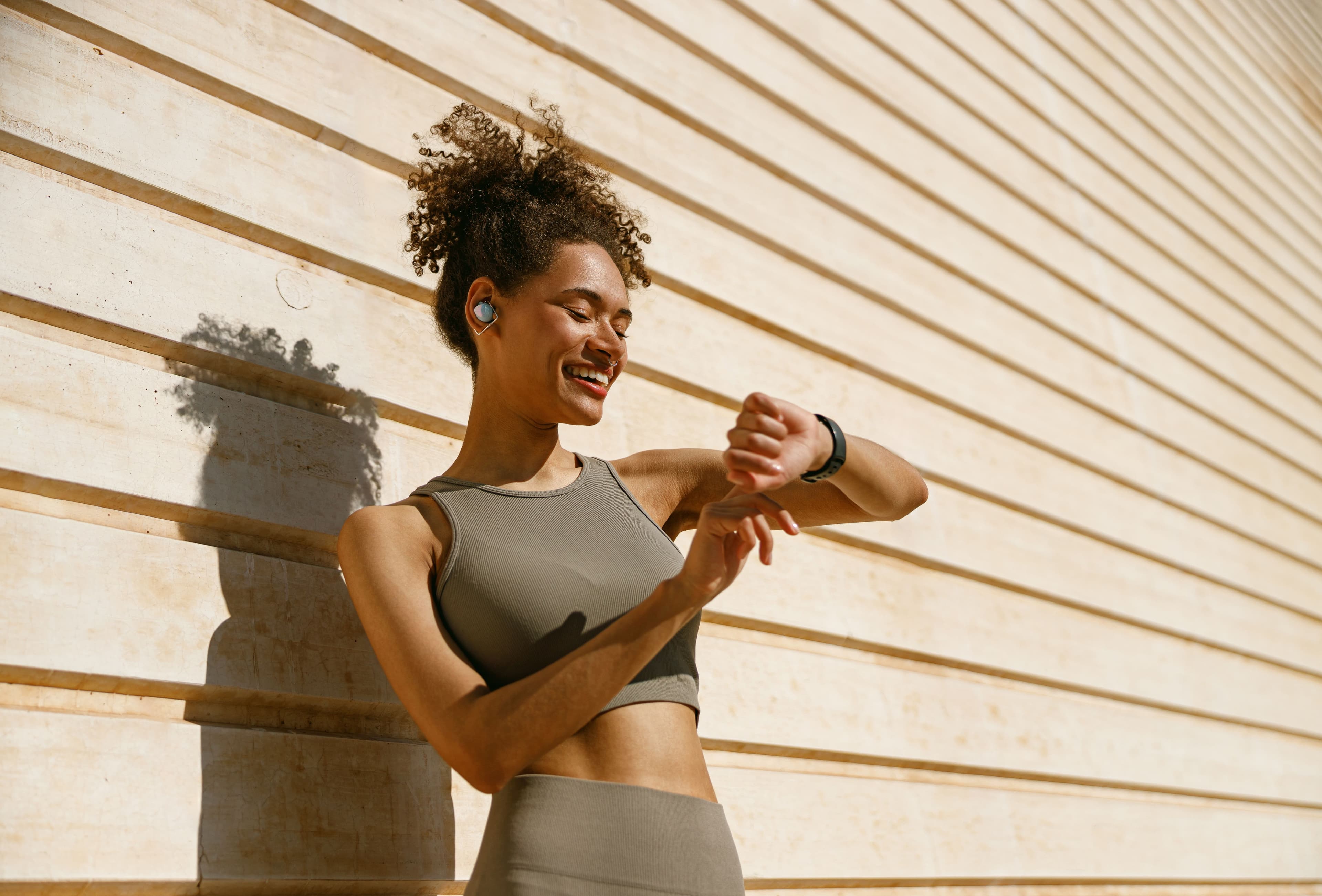5 Best Red Light Therapy Devices (That Are Also HSA-Eligible)
Author:Kathleen Ferraro
Reviewed By:Swapna Ghanta, MD&Michaela Robbins, DNP
Published:
October 13, 2025
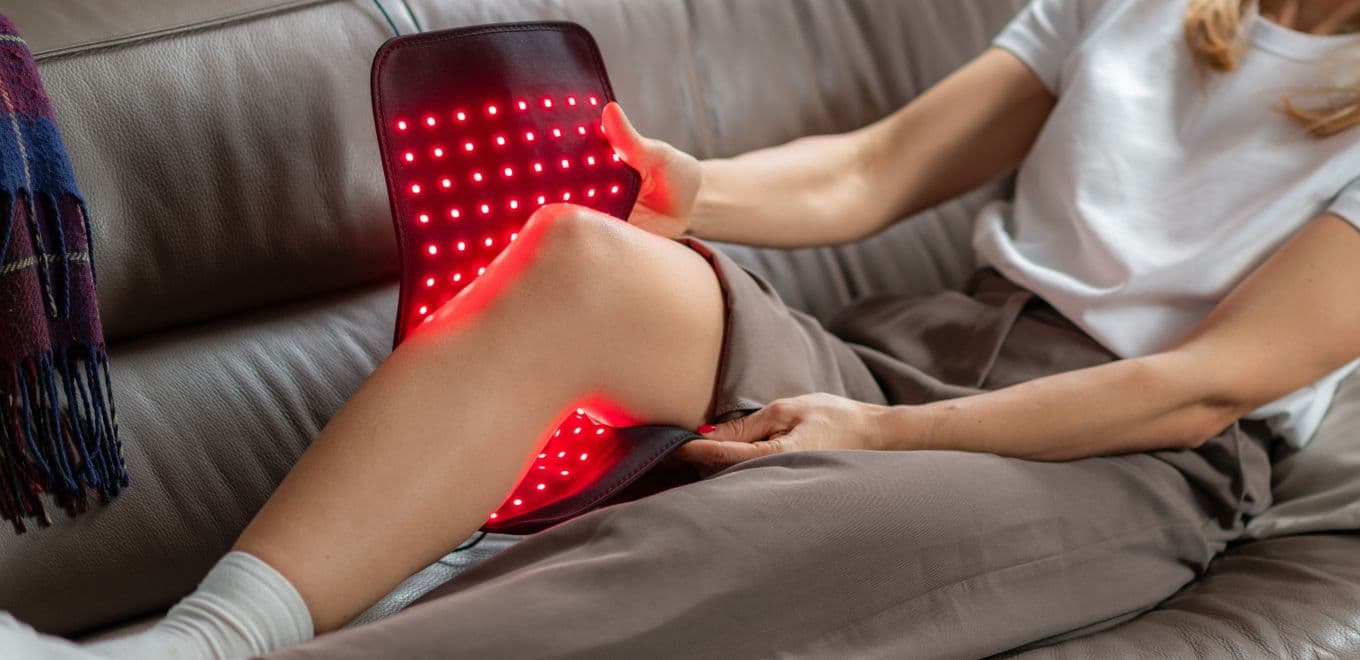
How Red Light Therapy Works
What Does the Evidence Say?
Safety Essentials
Device Types: Which Form Fits Your Goal?
What to Look For
Are Red Light Therapy Devices HSA/FSA-Eligible?
How to Use RLT Correctly
5 Best Red Light Therapy Devices
Affordable vs. Premium: What You Gain as You Spend More
Common Mistakes to Avoid
Key Takeaways
FAQ
5 Best Red Light Therapy Devices (That Are Also HSA-Eligible)
Think of red light therapy as a glow-up for your cells. No need to splurge on the fanciest panel—what matters is wavelength, power, and whether you’ll actually use it consistently. The good news? Many devices qualify as HSA/FSA-eligible healthcare expenses, and Truemed makes the process painless.
Chronic pain that won’t quit? Aching joints from arthritis? Stubborn acne? Red light therapy (RLT) has been studied for all of the above, and the good news is you don’t need to go to a clinic to try it—some of the best red light therapy devices bring the same intervention into your living room.
Red light therapy uses low-level wavelengths to penetrate the skin, says Ross Kopelman, MD, a hair transplant surgeon at Kopelman Hair Restoration in New York City. These light waves boost cellular energy production, which can help treat conditions like musculoskeletal pain, acne, and arthritis.
But here’s the catch: Not every gadget lives up to its claims. With so many masks, panels, handhelds, and caps on the market, it can be tough to know which of the best red light therapy devices are truly worth your money.
That’s where this guide comes in. We’ll highlight what the science says red light therapy can and can’t do and share experts’ top picks so you can put your HSA/FSA dollars to work on the right device.
How Red Light Therapy Works
Red light therapy works through a process called photobiomodulation, a fancy word that refers to light changing the way your cells behave, says Jessica Weiser, MD, a board-certified dermatologist, assistant clinical professor of dermatology at Columbia University, and founder of Weiser Skin MD in New York City.
When wavelengths of red light (roughly 630 to 680 nanometers) or near-infrared light (about 810 to 850 nanometers) hit your skin, they’re absorbed by the mitochondria—the “power plants” of your cells, says Kopelman. That boost helps mitochondria produce more ATP, the molecule your body uses for energy, adds Weiser.
This triggers a ripple effect, boosting cellular function, improving blood flow, and reducing oxidative stress—all of which help the body’s natural repair processes, says Kopelman.
Red light mostly stays at the surface, making it useful for skin-level changes like reducing fine lines or restoring hair growth, says Kopelman. Near-infrared light (NIR) penetrates deeper into muscles and joints, which may help with soreness, recovery, or chronic pain.
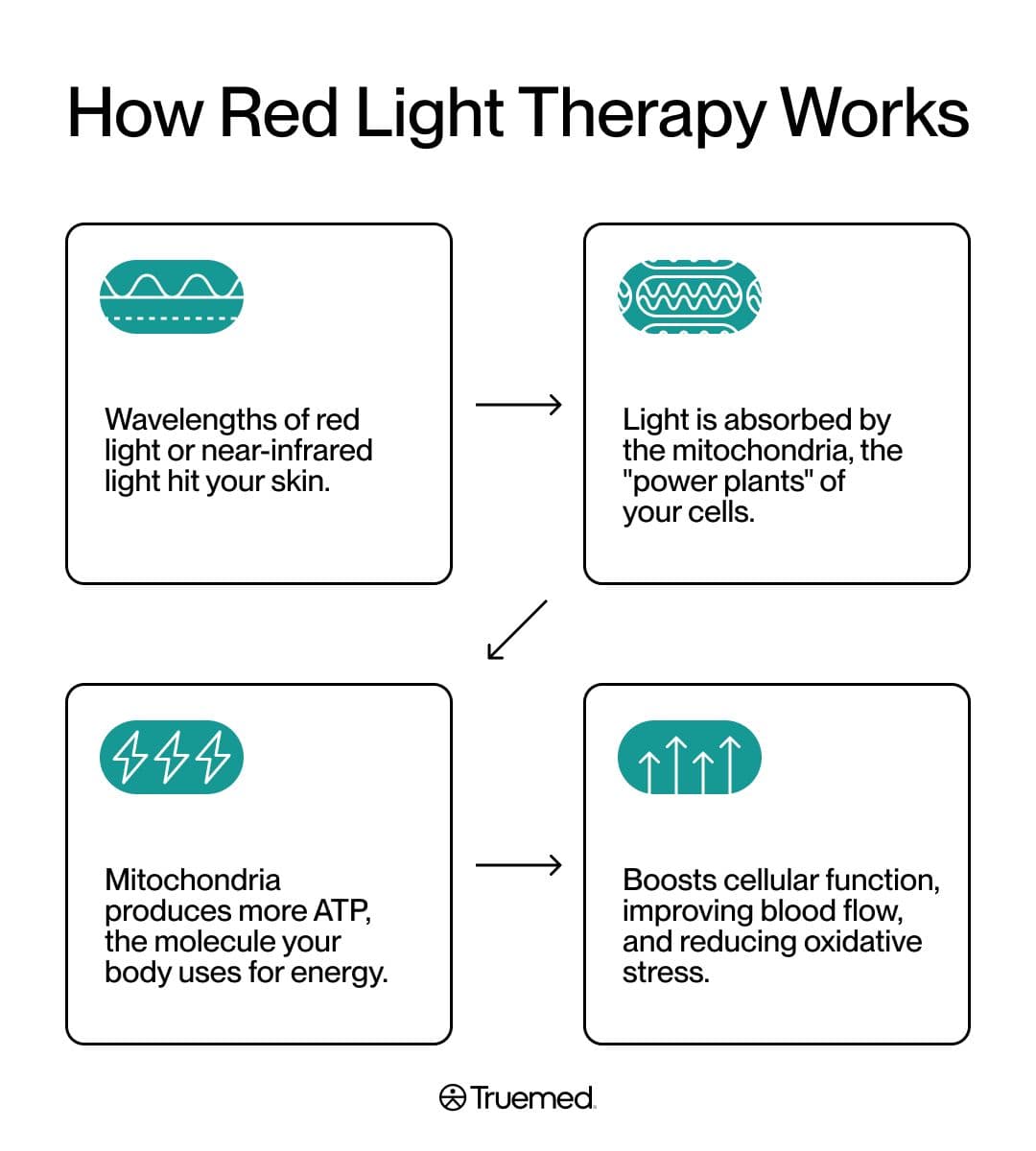
What Does the Evidence Say?
Red light therapy currently shows the most promise for skin health. Research shows that RLT can even support wound healing by speeding up the body’s natural repair processes. There’s also evidence that it can help with chronic skin conditions like inflammatory acne and acne scarring by calming inflammation and supporting skin barrier function.
For pain and recovery, results are encouraging, too. Research suggests that red and near-infrared light can temporarily reduce joint pain and muscle pain, especially in people with chronic conditions like arthritis, fibromyalgia, and back pain.
Similarly, early animal research suggests red light therapy may also help calm inflammation. In one experiment, mice that received red and near-infrared light had fewer inflammatory signals and more anti-inflammatory ones, hinting at a potential role for RLT in calming the body’s immune response.
Early research also suggests red light therapy may help with hair growth. In one study, men with thinning hair used a red light helmet a few times a week. After four months, those who used the real device grew noticeably more hairs—about a one-third increase—compared to men who used a placebo.
Experts think the light helps by waking up sluggish hair follicles and keeping hair in its growth phase longer, according to Weiser. “Additionally, [red light] reduces inflammation and stimulates circulation at the scalp and hair follicle level to further support a healthier scalp and improved hair growth,” she says.
Some athletes also use RLT as a recovery tool, though the performance benefits are less clear. One study found that photobiomodulation helped reduce localized muscle soreness (especially in the calves) after intense sprinting, but it didn’t improve measures like jump height or agility. In other words, it may ease discomfort after hard training, but it’s not a shortcut to better performance.
That theme applies across other uses too: The benefits tend to be gradual and moderate rather than dramatic, says Kopelman.
“Results come from steady, long-term use rather than a single session,” he adds.
RLT devices used in a medical office are often higher-intensity than those approved for home use. Although you can still get good benefits from home products, the results may vary from in-office treatment.
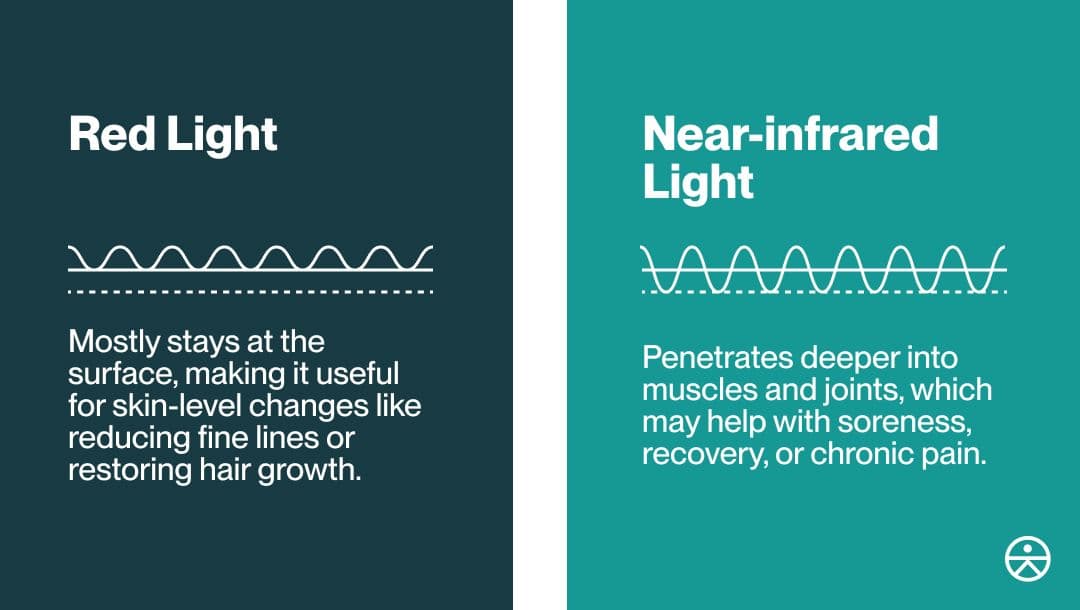
Safety Essentials
Red light therapy is generally considered very safe, especially compared to more invasive treatments like injections or surgery, says Kopelman. In fact, side effects are rare, according to Weiser. That said, there have been occasional reports of burns or blisters from improper use—for example, if someone fell asleep with the device on.
That said, Kopelman says a few safety basics matter:
- Protect your eyes: “The main consideration is avoiding direct exposure to the eyes, as the light can be intense,” he says. Always wear the goggles that come with your device when treating your face or staying close to the panel.
- Know your health history: If you take photosensitizing medications (like certain antibiotics, diuretics, or acne drugs) or have a photosensitive condition (like lupus), check with your doctor before starting RLT to make sure it’s safe.
- Be cautious with certain conditions: Avoid using red light directly over areas of active cancer unless cleared by your oncologist, since the evidence on safety is still mixed. The same caution applies after recent cosmetic procedures, like chemical peels or injectables, when skin may be especially sensitive. Always follow your provider’s instructions if you’ve had any recent skin procedures.
- Pregnancy and breastfeeding: Research is still limited, so it’s best to talk with your healthcare provider before using RLT during pregnancy or while nursing.
Device Types: Which Form Fits Your Goal?
The “best” device really depends on what you’re trying to treat and how much of your body you want to cover. Here’s the breakdown, according to the experts:
- Full-body panels: These tall light panels deliver the highest coverage and strongest output, making them a good fit if your goal is whole-body recovery, chronic pain relief, or treating multiple areas at once.
- Face masks: Designed for targeted skin support, these convenient, hands-free masks shine red light directly onto your face to address concerns like fine lines and acne.
- Handheld or spot devices: These smaller units target localized pain points or small treatment areas—think sore elbows, knees, or patches of skin. They’re usually more affordable and portable, but less efficient for larger body regions.
- Wraps or sleeves: These flexible designs contour around your joints, calves, or lower back. They combine the portability of a handheld with more coverage, making them useful for people managing arthritis, tendonitis, or post-workout soreness.
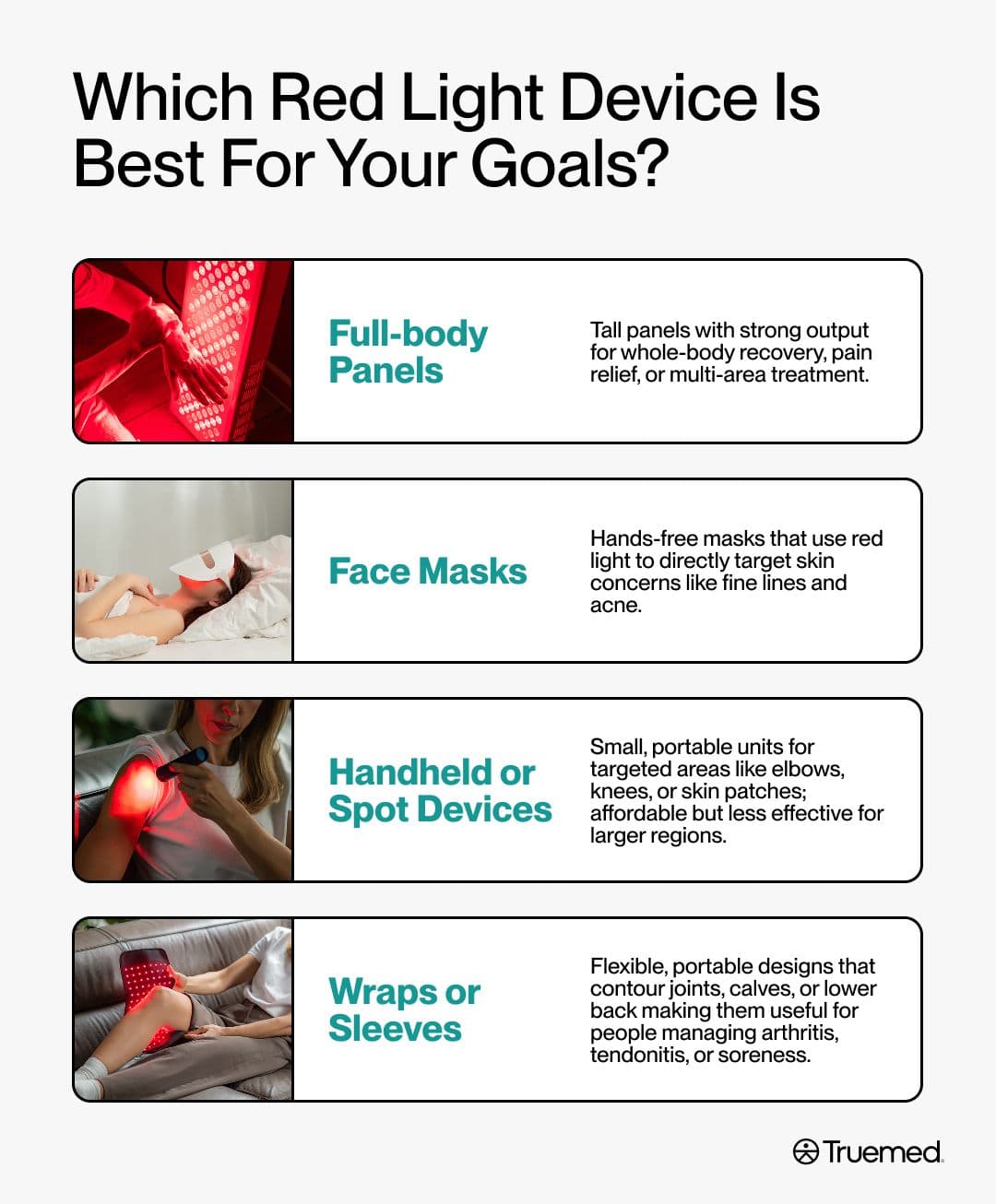
What to Look For
With so many devices on the market, specs—not marketing—are what separate the best red light therapy devices from the rest. Here’s what to pay attention to when you’re comparing options, according to Weiser and Kopelman:
- Wavelengths: Look for devices that offer both red light (around 630 to 660 nanometers) and near-infrared light (around 810 to 850 nanometers). Red supports skin-level changes, while NIR penetrates deeper into muscles and joints.
- Irradiance and dose: When you see marketing for the “strongest at-home red light therapy,” focus less on raw wattage and more on whether the device delivers consistent light intensity (irradiance) at a practical distance. Experts recommend devices with irradiance measured at six to 12 inches, meaning the light is still strong enough to deliver a therapeutic dose without needing to press the panel directly against your skin.
- Treatment time: The “dose” you get depends on both the light’s intensity and how long you use it. That said, most protocols call for about five to 20 minutes per area, up to five times a week, depending on your condition. Always follow the timing guidelines from your device manufacturer or clinician, because more time won’t speed results and can sometimes irritate the skin.
- Beam angle and coverage: Wider beam angles cover more area, but intensity drops off faster with distance. A good device balances both—enough spread to be efficient without losing effectiveness.
- Build and safety: Choose products with low EMF and flicker, solid cooling or thermal management, protective eyewear included, and clear third-party testing certifications. Look for a device that feels durable and well-made (skip the flimsy plastic), with a warranty that lasts beyond the first 30 days—both are signs of higher quality.
- User experience (UX): Look for features that make the device easy to use consistently. Built-in timers, adjustable intensity levels, the option to toggle between red and NIR light, app control, or even quiet fans can all make treatments more convenient and sustainable.
- Budget tiers: Affordable red light therapy devices (like small handhelds or masks) are great for spot treatments or first-time users. Mid-range options (compact panels) cover one body area at a time, and premium systems (large panels or full-body setups) typically offer the most coverage, smart features, and durability.
- Published third-party research: It’s preferable if the company producing the red light therapy device has independently vetted research that discloses stats on the device’s efficacy.
Are Red Light Therapy Devices HSA/FSA-Eligible?
The short answer: Yes, many red light therapy devices qualify for HSA or FSA coverage—but only when they’re prescribed for a medical need. That’s because the IRS defines eligible expenses as those used to “diagnose, treat, or prevent” a health condition. For red light therapy, that might include acne, chronic musculoskeletal pain, wound healing, or even neuropathic pain.
To unlock those benefits, you’ll need a letter of medical necessity (LMN) from a licensed clinician. This documentation serves as proof for your HSA/FSA administrator that the purchase meets IRS requirements. An LMN should clearly state:
- Your diagnosis or the condition being treated
- The device type and intended purpose
- Recommended frequency and duration of use
- Your clinician’s signature
Truemed makes the process simple by:
- Checking your eligibility: Complete an online intake survey to see if your health needs qualify you for medical use.
- Providing documentation: A licensed clinician reviews your survey and, if appropriate, issues an LMN.
- Unlocking savings: With your LMN in hand, you can confidently put HSA or FSA dollars toward a red light therapy device on Truemed’s marketplace.
How to Use RLT Correctly
When it comes to red light therapy, consistent, measured use works best, says Kopelman. A few minutes, several times a week, is far more effective (and safer) than occasional marathon sessions. Here are the basics:
- Frequency and duration: “I typically recommend patients use their device three to four times a week for about 15 to 20 minutes per session,” says Kopelman. “The goal is to provide enough stimulation without overexposure.” After four to eight weeks of this, many people transition to fewer maintenance sessions each week.
- Distance: Follow the manufacturer’s chart for how far to sit or stand from the device so you hit the right “dose” of light without overdoing it.
- Placement: Start with clean, dry skin and remove any photosensitive topicals (like retinoids) beforehand. Always use protective eyewear, says Kopelman.
- Track your progress: Take photos in the same lighting or keep a simple log of your skin changes, hair growth, or whatever you’re targeting. This makes it easier to spot gradual improvements you might otherwise overlook.
5 Best Red Light Therapy Devices
Every device on this expert-recommended list of RLT devices has two things in common: solid specs and the potential to qualify for HSA/FSA use with an LMN.
Truemed can help you obtain this letter so you can purchase one of these devices with pre-tax dollars—just be sure to keep your LMN and receipt for your records.
1. Best Red Light Therapy Mask: LightStim Elipsa
Kopelman recommends the LightStim Elipsa ($2,495) for general skin health because it’s reliable, research-backed, and FDA-cleared. This full-face mask contains 868 professional-grade LEDs using LightStim’s patented MultiWave® technology, which combines multiple wavelengths of light (including blue, amber, light red, and dark red) to target both fine lines and acne.
Treatment is simple: Use it three to five times per week, with 16-minute sessions for wrinkles and 12-minute sessions for acne.
2. Best Budget Face Mask: iRestore Illumina Face Mask
Kopelman’s next pick is the iRestore Illumina Face Mask ($399), an FDA-cleared device designed for targeted skin health. It features 360 medical-grade LEDs and three treatment modes:
- Mode 1: Red (635 nm) and infrared (830 nm) light for anti-aging and skin repair
- Mode 2: Red, infrared, and blue (415 nm) light for redness, scars, and sun damage
- Mode 3: Blue light only for breakouts
Each session takes just 10 minutes, three to five times per week. The Illumina is also one of the best LED face masks because it’s IEC safety-tested, ISO quality-assured, and comes with a one-year warranty.
3. Best for Hair Growth: Capillus Pro Cap
The FDA-cleared Capillus Pro Cap ($1,699) uses 272 medical-grade 650 nm lasers to deliver full scalp coverage in just six minutes a day. Lightweight and hands-free, it’s designed for convenience and consistent use.
Kopelman recommends Capillus because it has clinical studies backing its results for hair density and shedding. Its medical-grade lasers, auto shut-off, and three-year warranty add to its reliability, making it a strong choice for hair regrowth support.
4. Best Handheld Device: LightStim for Wrinkles
Kopelman also recommends LightStim for Wrinkles ($249), the brand’s handheld device that’s FDA-cleared and designed to reduce fine lines and support skin rejuvenation. It uses LightStim’s MultiWave® technology to target both surface-level and deeper skin layers. Each area only takes about three minutes, making it one of the most accessible ways to bring professional-level light therapy into your routine.
5. Best Panel: LightStim ProPanel
Once again, LightStim gets Kopelman’s recommendation for general skin concerns. The LightStim ProPanel ($6,500) is a professional-grade device with three models designed to target wrinkles, acne, or pain. Its large treatment head delivers consistent output across broader areas like the torso, back, or legs, making it a strong choice for larger-area concerns. Typical sessions last 10 to 20 minutes, a few times per week.
It’s also FDA-cleared and built with thermal control for comfort, making it one of the strongest red light therapy at-home treatments.
Affordable vs. Premium: What You Gain as You Spend More
Not every red light therapy device has to be a wallet-busting full-body panel. What you choose should match your goals and your budget.
Just remember: “It’s always better to use devices that are FDA-cleared,” says Weiser. “It implies safety and efficacy, and simultaneously shows that the company is invested in the quality of the product.”
Here’s how the tiers stack up:
- Affordable (entry-level handhelds or masks): This option is best if you’re just getting started or only need to treat small areas like your face, scalp, or a single joint. These devices are compact, portable, and budget-friendly, but they cover less surface area and may require repositioning to treat multiple spots. They’re ideal for spot treatments or testing whether RLT is right for you. Just be selective: “I would avoid cheap LED caps in general, partly because they will have minimal if any efficacy, and partly because they probably do not have consistent wavelengths,” says Weiser.
- Mid-range (compact panels or high-coverage masks): These strike a balance between coverage and cost. A mid-size panel can treat one body area (like your back or legs) at a time, reducing how often you need to move the device. They typically have stronger, more consistent light output than budget gadgets, cutting down on session time while delivering more reliable dosing.
- Premium (large panels or full-body systems): At the top end, you’ll find devices with the best output consistency, broader coverage, and extra features like programmable timers, red/NIR toggles, app controls, or quieter fans. They also tend to last longer, with sturdier builds and extended warranties. Premium systems shine when you’re treating multiple areas regularly, sharing the device with other household members, or aiming for whole-body goals like recovery and inflammation support.
Common Mistakes to Avoid
Red light therapy is safe and simple to use, but there are a few pitfalls that can limit your results or even cause irritation if you’re not careful, says Kopelman. These include:
- Chasing “max power”: More isn’t always better. Overexposure can irritate your skin and won’t speed results, so stick to recommended times and distances.
- Never reassessing: Using a device daily, indefinitely, without checking in on your progress isn’t necessary. Most people benefit from frequent use at first, then tapering to maintenance.
- Skipping eye protection: The light is intense, especially in close-up face sessions. Always wear the goggles that come with your device.
- Treating it as a magic fix: RLT can help, but it’s not a cure-all. Consider it a complement to a well-rounded treatment routine.
Red light therapy can help with certain conditions: It works by giving your cells an energy boost, which can support gradual improvements in skin, hair, pain, and recovery.
There's research to back it up: The most evidence-backed uses are for skin aging, acne, wound healing, and temporary pain relief.
Safety matters: Wear eye protection, avoid use if you’re on photosensitizing meds or have certain medical conditions, and always follow device guidelines.
The “best” device depends on your goals: Handhelds and masks are great for spot treatments, while panels cover larger areas for pain or recovery.
Skip the “max power” hype: What matters is choosing an FDA-cleared device with proven wavelengths, steady output, and a design you’ll actually stick with.
Many devices qualify for HSA/FSA coverage: You'll need to provide a letter of medical necessity, and Truemed simplifies the process.
Editorial Standards
At True Medicine, Inc., we believe better health starts with trusted information. Our mission is to empower readers with accurate and accessible content grounded in peer-reviewed research, expert insight, and clinical guidance to make smarter health decisions. Every article is written or reviewed by qualified professionals and updated regularly to reflect the latest evidence. For more details on our rigorous editorial process, see here.
